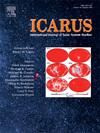Investigating the formation and growth of Titan's atmospheric aerosols using an experimental approach
IF 2.5
2区 物理与天体物理
Q2 ASTRONOMY & ASTROPHYSICS
引用次数: 0
Abstract
Titan has a climate system with similarities to Earth, including the presence of a thick atmosphere made up of several atmospheric layers. As on Earth, Titan's climate is influenced by several factors: the gaseous species making up the atmosphere, the energy deposited on the satellite, and solid organic aerosols. Indeed, numerous observations have revealed the presence of solid particles in the form of an opaque orange haze in Titan's atmosphere, influencing radiation balance and atmospheric dynamics, for example. However, the influence of these suspended solid particles seems to evolve according to the atmospheric altitude where they are located, certainly testifying to the presence of organic solids with different physico-chemical properties. At present, it is suspected that several populations/classes of atmospheric aerosols may form following different chemical pathways, and that aerosols undergo growth processes that modify their properties. In this experimental study, we present new observations on the evolution of morphological and chemical properties observed on Titan aerosol analogues, produced from a mixture of 20 % CH4 and 80 % N2 injected into a dusty RF plasma experiment. Using SEM (morphological) and FTICR-LDI-MS (chemical composition) analyses, we observe that properties evolve according to certain formation and growth mechanisms, which differentiate over time. The evolution of the neutral gaseous chemical composition analyzed in-situ by QMS in parallel shows correlations with the evolution of solid properties, testifying to the selective involvement of certain neutral products in the formation and growth mechanisms of solid aerosols. By linking the analyses of the gas phase and organic solids, we propose the calculation of an uptake coefficient between six neutral gaseous products (C2H2, HCN, C2H6, C2H3N, HC3N, C2N2) and the surface of the Titan aerosol analogues produced in this study.
求助全文
约1分钟内获得全文
求助全文
来源期刊

Icarus
地学天文-天文与天体物理
CiteScore
6.30
自引率
18.80%
发文量
356
审稿时长
2-4 weeks
期刊介绍:
Icarus is devoted to the publication of original contributions in the field of Solar System studies. Manuscripts reporting the results of new research - observational, experimental, or theoretical - concerning the astronomy, geology, meteorology, physics, chemistry, biology, and other scientific aspects of our Solar System or extrasolar systems are welcome. The journal generally does not publish papers devoted exclusively to the Sun, the Earth, celestial mechanics, meteoritics, or astrophysics. Icarus does not publish papers that provide "improved" versions of Bode''s law, or other numerical relations, without a sound physical basis. Icarus does not publish meeting announcements or general notices. Reviews, historical papers, and manuscripts describing spacecraft instrumentation may be considered, but only with prior approval of the editor. An entire issue of the journal is occasionally devoted to a single subject, usually arising from a conference on the same topic. The language of publication is English. American or British usage is accepted, but not a mixture of these.
 求助内容:
求助内容: 应助结果提醒方式:
应助结果提醒方式:


